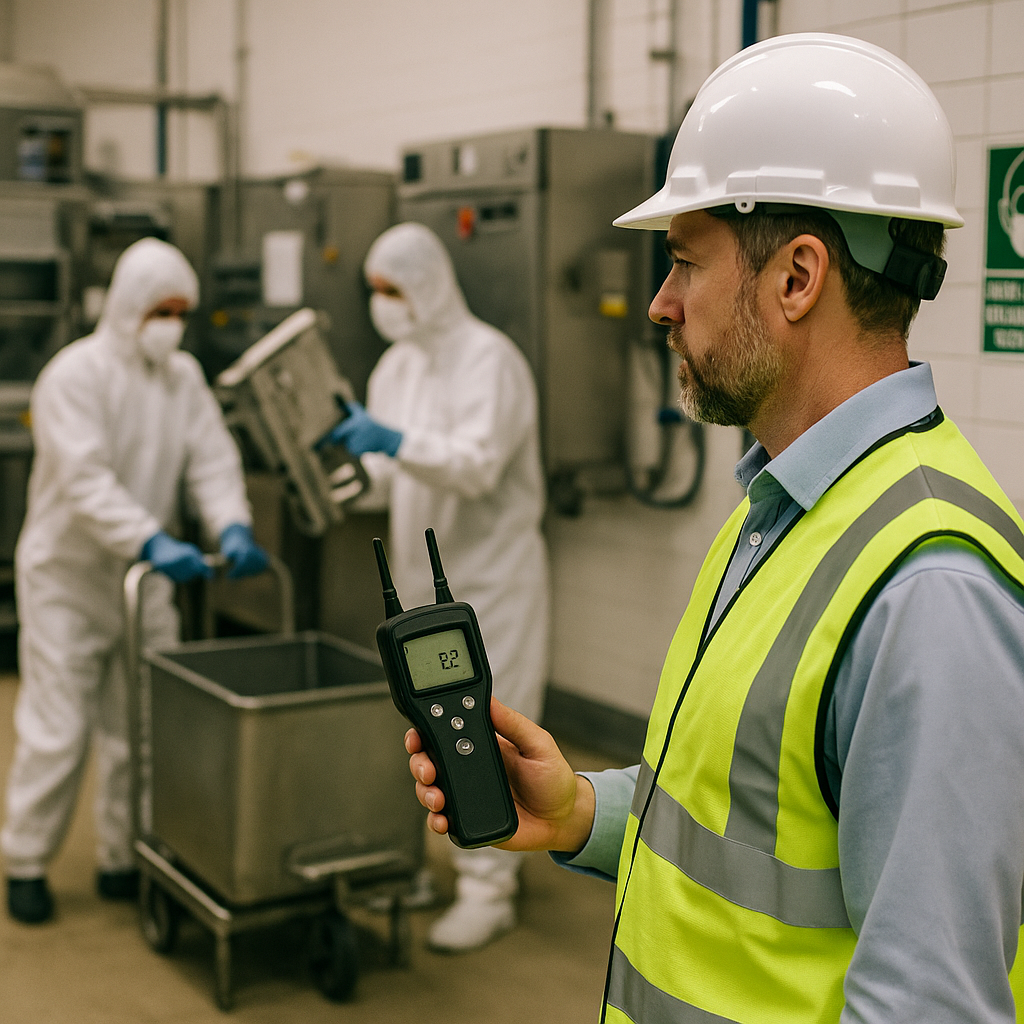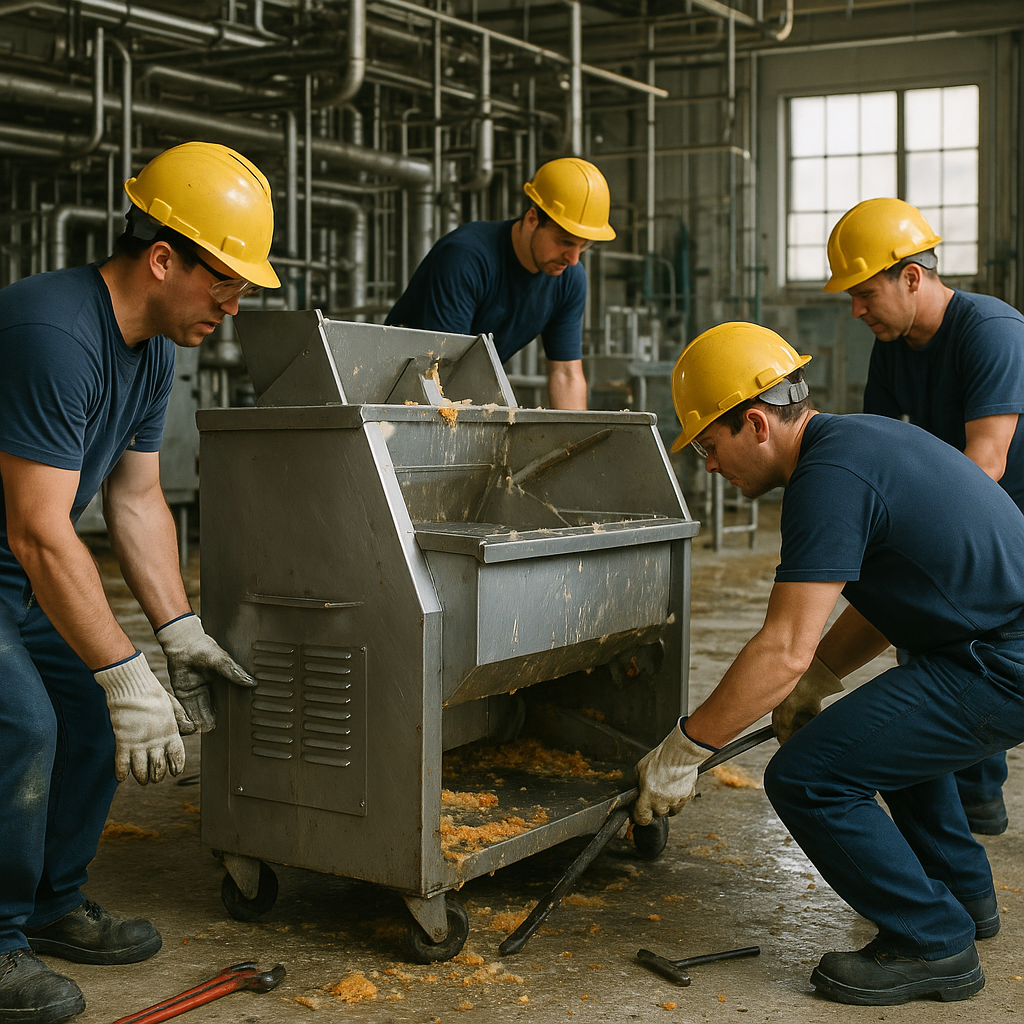5901 Botham Jean Blvd, Dallas, TX 75215
A Quick Guide to Decommissioning a Food Processing Plant
August 7, 2025Decommissioning a large-scale food processing plant involves more than just shutting down machinery. It requires methodically ending operations, dismantling equipment, and preparing the site for its next phase—be it repurposing, sale, or closure.
When a food processing facility reaches the end of its operational life, a structured approach is essential. This process calls for careful planning to address regulatory compliance, environmental concerns, and the safe handling of specialized equipment. Each step must be executed with precision to prevent regulatory penalties and environmental contamination.
Food processing plants present unique decommissioning challenges compared to other industrial facilities. The presence of food-grade equipment, specialized sanitation systems, and potential hazards like ammonia refrigeration systems demands targeted expertise. These facilities often include complex processing lines, cold storage areas, and waste treatment systems that require proper shutdown procedures.
What Are the Key Steps in Planning a Food Plant Decommissioning?

Effective planning lays the groundwork for a successful food plant decommissioning project. Without thorough preparation, these complex projects can quickly become chaotic, unsafe, and financially burdensome. A detailed decommissioning plan ensures all regulatory requirements are met while maximizing asset recovery value.
Conducting a Thorough Site Assessment
The first step in planning a food plant decommissioning is conducting a detailed site assessment. This identifies the scope of work and potential challenges. Assessments for food facilities must account for specialized equipment and potential contamination issues unique to food processing environments.
A comprehensive site assessment typically includes:
- Mapping all operational areas, equipment locations, and utility connections
- Identifying hazardous materials, including refrigerants, cleaning chemicals, and ammonia systems
- Evaluating structural integrity for safe dismantling
- Analyzing potential environmental contamination from years of food processing operations
This crucial step provides the data necessary for developing a realistic project scope. Documentation during this phase should be meticulous, as it informs subsequent decision-making throughout the decommissioning process.
Creating a Detailed Asset Inventory
Food processing facilities contain valuable equipment potentially suitable for resale, repurposing, or recycling. An exhaustive inventory ensures nothing is overlooked during the decommissioning.
An effective asset inventory should:
- Document equipment with specifications, condition assessments, and current market value
- Categorize assets based on potential for resale, repurposing, or recycling
- Identify food-grade materials requiring special handling or certification for resale
- Determine which assets contain hazardous materials needing specialized disposal
Food processing equipment often retains significant value when properly decommissioned. Stainless steel components, specialized mixing equipment, and refrigeration systems can generate revenue when accurately cataloged and marketed to potential buyers.
Establishing a Timeline with Clear Milestones
Decommissioning projects operate under constraints like lease terminations, regulatory deadlines, and operational shutdowns. A well-organized timeline with defined milestones helps keep the project on track and prevents costly delays.
A decommissioning timeline should include:
- Sequential steps for safely shutting down operations
- Scheduling utility disconnections and service terminations
- Time for cleaning, decontamination, and equipment removal
- Coordination with regulatory inspections and compliance verifications
- Contingency buffers for unexpected challenges
For food facilities, timing often requires coordination with health department officials and food safety regulators who must verify proper decontamination of processing areas.
No table output available
Allocating Budget for Various Phases
Financial planning is essential for decommissioning projects as costs can vary significantly with facility size, equipment complexity, and environmental considerations. A detailed budget helps avoid financial surprises and ensures resources are available when needed.
Key budget considerations include:
- Labor costs for specialized decontamination and dismantling personnel
- Equipment rental for heavy machinery and specialized tools
- Disposal fees for hazardous materials and waste
- Environmental testing and compliance verification expenses
- Transportation costs for equipment being relocated or sold
The budget should account for potential revenue from equipment sales, which can offset some decommissioning costs. Food processing equipment in good condition often retains value in secondary markets, particularly stainless steel components and specialized machinery.
Performing a Comprehensive Risk Assessment
Food plants present unique decommissioning challenges, including sanitation concerns, ammonia refrigeration systems, and industrial cleaning chemicals. A thorough risk assessment identifies potential hazards and establishes mitigation strategies.
An effective risk assessment addresses:
- Environmental contamination risks from chemicals, oils, or refrigerants
- Worker safety concerns during dismantling and removal activities
- Regulatory compliance risks and potential penalties
- Structural hazards during equipment removal
- Specialized risks associated with food processing facilities, such as confined spaces in storage tanks
Risk assessment findings should inform safety protocols, training requirements, and equipment needs. For food facilities, special attention must be paid to ammonia refrigeration systems, which require specialized handling during decommissioning.
Ensuring Regulatory Compliance
Food processing facilities are subject to numerous regulations governing their closure and decommissioning. Compliance with these requirements is mandatory and should be incorporated into all planning activities.
Key regulatory considerations include:
- Environmental regulations for waste disposal and site remediation
- Occupational safety standards for workers involved in decommissioning
- Food safety regulations requiring proper sanitation and decontamination
- Local permitting requirements for equipment removal and building modifications
- Documentation requirements for hazardous material handling and disposal
Working with regulators early in the planning process helps identify compliance requirements and prevents costly violations. Many food facilities require formal closure notifications to health departments and food safety authorities.
Proper planning transforms what could be a chaotic and potentially hazardous process into a systematic, safe, and cost-effective project. Each step builds upon the previous one, creating a comprehensive roadmap for successful decommissioning. With careful preparation, food plant operators can minimize disruption, maximize asset recovery, and ensure regulatory compliance throughout the decommissioning process.
How Are Environmental and Safety Concerns Addressed?

Environmental and safety considerations are fundamental in responsible food plant decommissioning. When facilities that once processed consumable products reach the end of their operational life, dismantling requires meticulous attention to hazards that could affect workers, communities, and ecosystems.
Managing hazardous materials is a primary concern during decommissioning. Food processing plants often contain various chemical systems that need specialized handling. Ammonia refrigeration systems present significant risks if not properly deactivated and removed. These systems, common in cold storage areas, can release toxic gases if damaged during dismantling. Industrial cleaning agents, lubricants, and processing chemicals must be identified, cataloged, and disposed of safely according to regulations.
Before physical decommissioning begins, an Environmental Impact Assessment (EIA) is conducted to understand potential environmental risks. The EIA identifies threats to soil, groundwater, and air quality, helping decommissioning teams develop strategies to mitigate environmental harm during the process.
Waste management planning is crucial for environmentally responsible decommissioning. Food plants generate diverse waste streams during shutdown, including organic residues, packaging materials, equipment components, and potentially contaminated materials. Proper segregation enables appropriate recycling, repurposing, or disposal through authorized channels. Minimizing landfill impact is a priority, with metal components typically reclaimed for recycling and organic materials directed to composting facilities.
Sanitation protocols are particularly important in food plant decommissioning. Residual organic matter can harbor pathogens or attract pests if not addressed properly. Decommissioning teams must thoroughly clean and sanitize all food contact surfaces and processing areas to prevent biological contamination affecting workers or spreading to surrounding areas.
Regulatory compliance frameworks guide the entire decommissioning process. Food manufacturing facilities fall under multiple regulatory jurisdictions, including environmental protection agencies, food safety authorities, and occupational health administrations. Certified environmental experts typically oversee compliance with these requirements, ensuring all decontamination, waste handling, and site restoration activities meet stringent standards.
Worker safety protocols address unique hazards during food plant decommissioning, such as confined space entry procedures for cleaning tanks and vessels, fall protection during equipment removal, and respiratory protection against airborne contaminants. Comprehensive safety planning identifies risks before work begins, establishing control measures to protect the workforce.
Water management also requires careful attention, as food processing facilities often have extensive water systems that must be properly drained, cleaned, and disconnected. Preventing cross-contamination between wastewater and clean water protects local water resources from potential pollution during decommissioning.
Site remediation represents the final phase of environmental management, focusing on returning the property to a condition suitable for future use. This may involve soil testing, groundwater monitoring, and cleanup activities to address any contamination found during decommissioning.
This comprehensive approach to environmental and safety management ensures that food plant decommissioning proceeds without creating new environmental liabilities or safety hazards, allowing former production sites to transition safely to their next use.
[[artifact_table]] Common hazardous materials in food plant decommissioning and their management approaches [[/artifact_table]]What Unique Challenges Do Food Processing Plants Face in Decommissioning?

Food processing plants face specific challenges during decommissioning that distinguish them from other industrial facilities. These specialized environments require careful attention beyond standard shutdown procedures to ensure regulatory compliance and environmental safety.
A significant challenge is maintaining stringent hygiene standards throughout the decommissioning process. Unlike other industrial sites, food facilities must uphold strict sanitation protocols even during shutdown to prevent contamination. Years of food production often create hidden residues in processing equipment, drainage systems, and building structures that require specialized cleaning methods.
Equipment disposal poses another challenge. Food-grade machinery differs substantially from standard industrial equipment. Stainless steel processing lines, mixing vessels, and packaging systems must maintain proper certifications if they are to be resold, necessitating thorough documentation of maintenance records, sanitization history, and food safety compliance measures.
Most food processing plants operate complex on-site treatment systems that require professional decommissioning. These include wastewater treatment facilities, chemical storage areas, and refrigeration systems containing hazardous coolants like ammonia. Each system needs careful dismantling to prevent environmental contamination or safety hazards.
The regulatory environment adds complexity to food plant decommissioning. Multiple agencies typically have jurisdiction over different aspects of the facility. Health departments oversee food safety compliance, environmental agencies monitor waste management and potential contamination, while industrial regulators supervise equipment removal and building modifications. This oversight requires coordinated communication and documentation throughout the process.
Hidden contamination risks are prevalent in many food facilities. Production floors may harbor biological growth in cracks or joints after years of wet processing. Storage areas might contain undocumented chemical residues from cleaning agents or pest control substances. Each potential hazard requires identification and remediation for proper closure.
The specialized infrastructure in food plants creates unique demolition challenges. These facilities typically feature complex utility systems like steam lines, refrigeration piping, and specialized ventilation, all requiring careful removal. Floor drains, trench drains, and wastewater systems may harbor organic matter needing specific disposal methods.
Even the building itself demands special considerations. Food-grade wall coatings, specialized flooring, and sanitary room transitions need assessment during decommissioning. These materials may contain hazardous components or require specific disposal methods based on their composition and condition.
Cold storage areas present particular difficulties during decommissioning. These spaces often have ice buildup containing years of airborne particles and potential biological contamination. Defrosting and cleaning these areas require specialized approaches to prevent environmental releases during demolition.
Successfully addressing these challenges demands expertise specific to food processing facilities. Companies experienced in food plant decommissioning understand the industry standards, regulatory requirements, and technical considerations unique to these environments.
Given these complexities, food processing companies benefit from developing comprehensive decommissioning plans well before shutdown begins. Early planning allows for proper budgeting, regulatory consultation, and development of specialized protocols to address the unique aspects of food facility closure.
How Can Asset Recovery Be Maximized During Decommissioning?
Maximizing asset recovery is a key opportunity to offset costs during food plant decommissioning. Strategic planning and systematic inventory management can turn a potentially costly expense into a cost-neutral or even profitable endeavor.
Strategic Asset Identification and Inventory
The first step in effective asset recovery is conducting a comprehensive inventory of all salvageable equipment, including processing machinery, packaging systems, utilities equipment, and even structural components valuable in secondary markets.
A detailed asset registry should document each piece of equipment’s specifications, condition, age, maintenance history, and market value. Categorizing assets based on resale versus scrap value helps prioritize recovery efforts.
Food processing equipment often retains significant value when properly maintained. Stainless steel components, specialized processing machines, and recent-model packaging equipment typically command the highest resale prices.
Proper Documentation and Certification
Proper documentation is essential for maximizing resale value. Food-grade certifications, maintenance records, operating manuals, and original purchase information enhance marketability and value. Equipment with documented food safety compliance is particularly valuable, as buyers need assurance that equipment meets current regulatory standards. Preserving compliance documentation pays dividends during decommissioning.
Verification of proper decontamination procedures also adds value. Potential buyers will pay premium prices for equipment with documented sanitization processes that meet industry standards.
[[artifact_table]] Asset Recovery Value Comparison by Equipment Type [[/artifact_table]]Strategic Dismantling Approaches
The method of equipment removal significantly impacts recovery value. Hasty demolition can damage valuable assets. A systematic dismantling approach preserves equipment integrity and maximizes resale potential.
Experienced decommissioning teams follow established protocols for disconnecting utilities, removing interconnected systems, and preserving critical components. This careful approach maintains the value of complex systems that might otherwise be damaged during removal.
Sequential dismantling allows for better organization of assets for resale. Components can be grouped logically, photographed, and documented, making them more attractive to potential buyers.
Leveraging Resale Networks
Working with specialized equipment resellers and auction networks significantly expands the potential buyer pool. These partners have established channels for reaching interested buyers in relevant industries.
Online auction platforms have transformed the used equipment market, creating global marketplaces for industrial machinery. Professional auction services handle marketing, bidding processes, and transaction management, maximizing returns while minimizing the seller’s administrative burden.
Timing auctions strategically can also impact recovery values. Understanding seasonal demand patterns in the food processing industry helps determine optimal selling windows for specific equipment types.
Recycling and Materials Recovery
For equipment that cannot be resold intact, materials recycling offers additional recovery value. Stainless steel, copper, aluminum, and other metals found in food processing facilities command significant prices in recycling markets.
Modern recycling facilities can process complex assemblies, separating valuable materials efficiently. Establishing relationships with metal recyclers before decommissioning begins ensures competitive pricing for scrap materials.
Even non-metallic components may have recycling value. Plastic components, rubber belting, and certain electronic parts can be processed through specialized recycling channels, further reducing disposal costs and environmental impact.
Financial Impact of Strategic Asset Recovery
When executed properly, asset recovery can significantly offset overall decommissioning costs. In some cases, the value recovered through equipment resale and materials recycling can make the entire decommissioning project cost-neutral.
Key financial benefits include immediate cash recovery from equipment sales, reduced disposal costs, and potential tax benefits from donations of usable equipment to educational institutions or nonprofit organizations.
Careful planning and professional management of the asset recovery process typically deliver returns that far exceed the additional investment required. Most food processing facilities contain millions of dollars in recoverable asset value that would otherwise be lost in standard demolition approaches.
Conclusion: Ensuring a Successful Food Plant Decommissioning

Decommissioning a large-scale food processing plant is a complex task that demands meticulous planning and execution. The process requires specialized expertise to address industry-specific challenges, such as handling food-grade equipment, adhering to sanitation protocols, and managing hazardous materials. Companies that strategically approach decommissioning can turn potential regulatory burdens into opportunities for asset recovery and value preservation.
Regulatory compliance is fundamental to any successful decommissioning project. Food facilities must comply with strict environmental regulations during closure to prevent contamination and ensure proper disposal of processing chemicals, refrigerants, and other controlled substances. Thorough documentation throughout the process safeguards against potential fines and liability issues that could arise years after project completion.
For your food processing plant decommissioning needs, contact Okon Recycling at 214-717-4083. Our team of specialists can help you navigate regulatory requirements, maximize asset recovery, and ensure your decommissioning project proceeds safely and efficiently.
